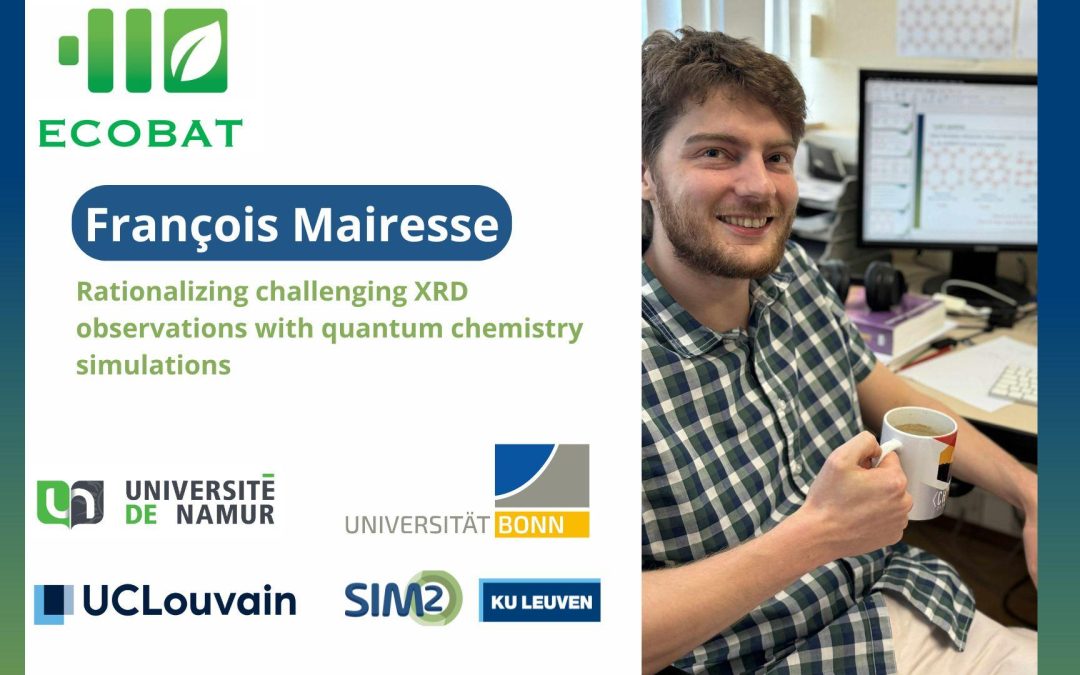François Mairesse was born in Namur and grew up in Arlon, Belgium. He completed both his bachelor’s and master’s degrees in chemistry at the University of Namur, which has a renowned chemistry department. After finishing his master’s studies, he had the opportunity to join Professor Benoît Champagne’s team as a teaching assistant, a role he has held for five years. At the same time, he is working on his PhD thesis, titled “Quantum Chemical Investigations of the Organic and Organometallic Crystalline Solid State – Design of Materials with Outstanding Electronic, Electrical, Optical, and Electro-Optical Properties”.
He teaches general chemistry to first-year students in the faculties of medicine and science. His responsibilities include both theoretical lessons and laboratory works, as well as exercise sessions and practical classes related to Professor Benoît Champagne’s courses on quantum chemistry and group theory.
What do you do for ECOBAT?
For ECOBAT, I help Professor Alex Vlad from UC Louvain to rationalize observations in X-ray diffraction (XRD) results for metal-organic frameworks (MOFs). The MOFs synthesized in Alex Vlad’s group are candidates for cathode or charge storage materials. The title of my work is “Rationalizing challenging XRD observations with quantum chemistry simulations.” An article about this was published last month.
Why do we need to resolve XRD structures of these MOFs?
The original idea behind the MOF synthesis was to use chemical groups such as phosphonates and hydroquinones within one molecule to potentially hold a large amount of charge. The researchers in Alex Vlad group observed that depending on the degree of hydration, they had difficulties resolving the XRD structure. Resolving the XRD structure is important because chemical properties of a material depend on the shape, structure, and arrangement of the chemical groups, molecules, and atoms. If we do not know their positions relative to each other, it becomes difficult for a chemist to analyze results or design new experiments.
What is your biggest challenge in ECOBAT?
The work that I just described has actually been quite challenging. Theoreticians have access to atomic positions and properties in ways that experimentalists cannot directly observe, but they also typically require precise information about “what to simulate” in order to function properly. It was a circle: we, theoreticians, had to provide structural information, but we needed it in order to simulate anything. I had to make informed assumptions, run simulations based on those assumptions, and analyse the outcomes, such as changes in the XRD spectra. There is water inside the MOF crystals that affects their overall structure, and we aimed to determine where this water is located and how it influences the material. This was a complex question because it was somewhat open-ended and there is not really a designated method to answer it.
What is the most interesting aspect of the ECOBAT project?
The project is very interdisciplinary. Theory and experiment complement and support each other. Experimentalists can do things that we cannot simulate, and vice versa. Also, battery research has been a very hot topic in recent years. It is a highly competitive field, and I believe there are not many collaborations like ECOBAT that bring these different approaches together.
We are talking about battery research here. How do you recharge yourself?
I keep it simple! I like going out with friends, spending time with my girlfriend, and reading books. It is nice to take a break and not think too much sometimes. The last series I watched was “The House of the Dragon”, it was pretty good!
What is your special talent?
I can draw pretty accurate portraits of people, and I enjoy making videos with my friends for fun.
To learn more about the research in the group of Professor Benoît Champagne, visit this page.

